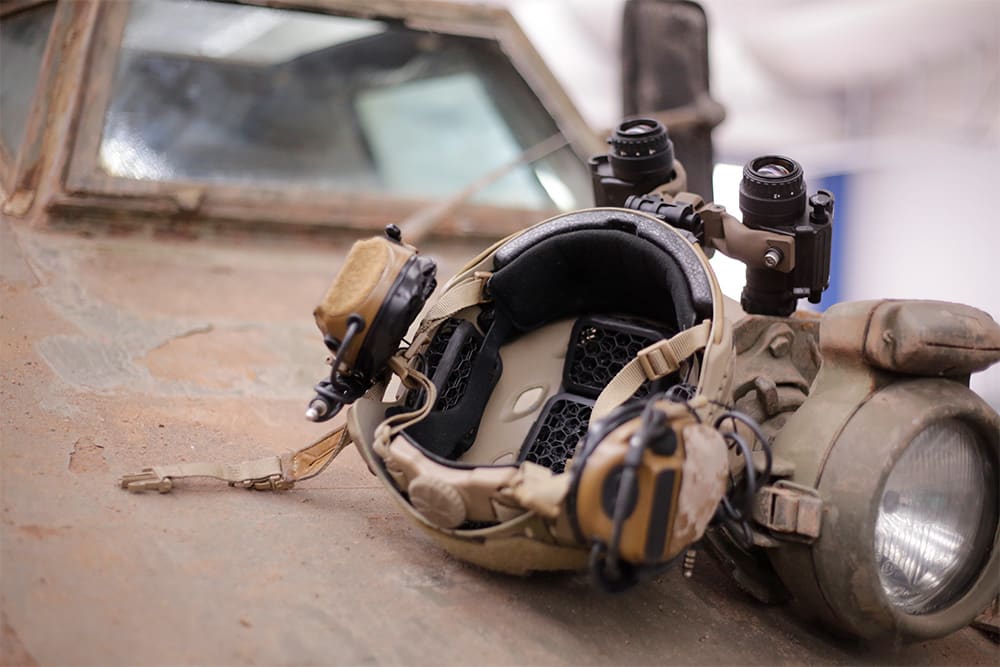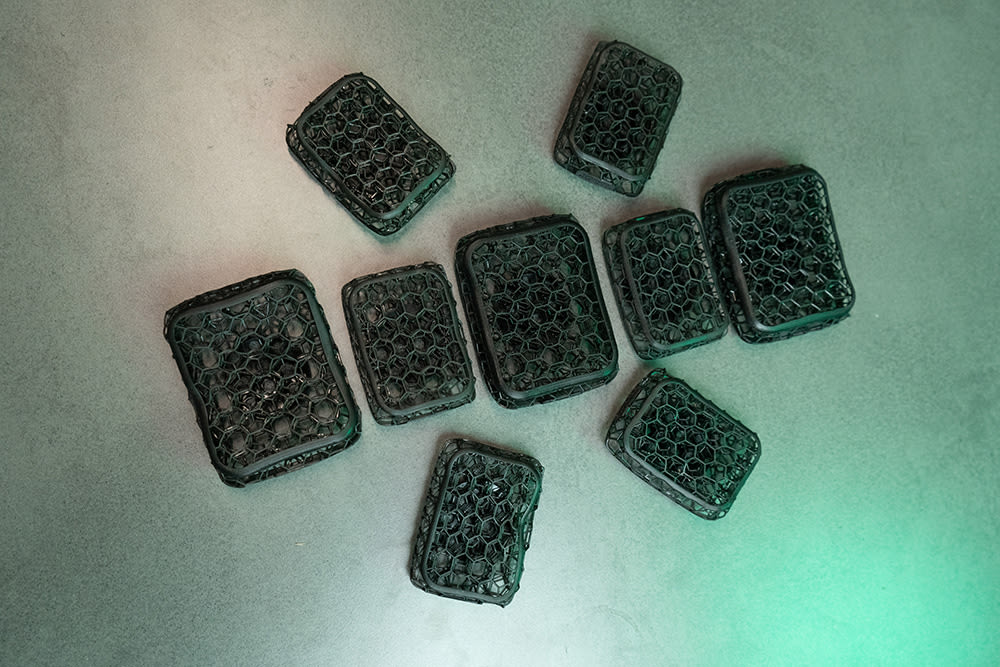Send-Nods and rpm Seek to Improve Comfort and Protection for Tactical Helmets

Key Takeaways:
- Send-Nods chose to use the Carbon Digital Light Synthesis™ (Carbon DLS™) 3D printing process for the design, development, and production of the Send Impact AirPad System by Carbon production partner rpm to increase comfort and protection in European tactical helmets.
- rpm used their five years of experience in lattice development and a company focus on small series production to keep a rapid pace towards launching the product while still meeting the cost demands for end-sale.
- Carbon’s Design Engine Pro™ software enabled production of a tunable lattice to meet specific mechanical requirements for higher compression rates in the weighted helmet while still maintaining a layer of comfort cushioning and breathability through the lattice structure design.
- Carbon’s EPU 43 material met the damping and durability requirements while offering a comfortable feeling for continuous wear in strenuous conditions.
INTRODUCTION
Send-Nods, a military gear company, sought to improve upon traditional tactical helmets by introducing latticed padding to optimize comfort and protection. Having seen what was achieved using the Carbon DLS 3D printing process to produce similar helmet solutions in the U.S. market, Send-Nods chose to collaborate with Carbon production partner rpm to design, develop, and produce the AirPad System.
The AirPad System is an accessory helmet padding system consisting of nine individual latticed pads, which improve the comfort of tactical helmets by replacing standard foam pads and introducing airflow. The initial design launched is optimal for heavier ballistic helmets which are loaded with additional components like hearing protection, night vision, counterweights, and position lights to outfit soldiers in the field.
The standard foams react by collapsing under the components’ weight and no longer providing dampening behavior. On top of the weight, the foam helmet pads trap heat, creating an uncomfortable experience for the soldier. The benefits of latticed helmet designs are widely recognized, which inspired Send-Nods to develop the AirPad System specifically for EU helmet sizes and regulations. By partnering with German-based rpm, Send-Nods was able to design and produce all aspects of their innovative product within the European Union.

MATERIALS AND PART REQUIREMENTS
Send-Nods defined the following requirements for its AirPad System:
- Damping material that was comfortable to the touch
- Latticed cell design
- High breathability for the user
- Increased comfort and performance
- Production within the EU
Previously, these helmet padding systems were manufactured with standard foams, which limit breathability and have a linear response to weight.
SOLUTION
With a clearly defined product design and an understanding of the mechanical performance requirements under weight, Send-Nods set out to find the optimal partner and platform for production.
Finding the Right Partner
Send-Nods explored a few potential CPNs before deciding to work with rpm. From the outset, rpm quickly understood the project and helped refine the technical criteria to produce a successful product. They initiated a pre-evaluation prototyping phase of the EPU 43 and EPU 45 materials and selected the key mechanical properties. The speed and effectiveness of this first phase gave Send-Nods the confidence to move forward with rpm for design, development, and production.
Material
Send-Nods ultimately chose to produce the AirPad System with Carbon’s EPU 43 material. EPU 43 is a soft, durable material that is energy damping. This material offered the right balance between high-impact absorption and comfort on the head and skin for continuous daily use.
Lattice Designs for Cushioning and Performance
To make helmets more comfortable for soldiers, Send-Nods required a breathable design that performed well under a continuous heavy load to keep other functional accessories floating comfortably over the head.
rpm utilized Carbon Design Engine Pro™ software to generate multi-zonal lattices with varying cell types and strut diameters that could meet the compression depth requirement. Lattice designs were tested and optimized for the various pad sizes to have paired performance under load. The multi-zonal approach to the design enables a smooth transition between an impact protection layer and a comfort cushioning layer.
rpm used Design Engine Pro’s mechanical simulations to predict performance and aid in speeding up each development cycle. Designing and printing within the Carbon platform enabled rpm to test and update design iterations quickly. The final product is tuned to compress up to 50% under load, the maximum expected accessory weight, to maintain comfort cushioning for the soldier. The innate design of the lattice structure increases airflow for more breathability.

Faster Time to Market
rpm was able to move through five design iterations in two months, including field-testing by soldiers of several of the prototype iterations. Each phase included a clear design target and a functional performance requirement for the latticed pads. Following each field test, a new set of requirements was defined for the next phase.
Upon production of a prototype design, mechanical testing was performed to ensure that it met the defined compression goals of the product. The sets were then sent for field testing to determine both performance and functional limitations. The initial prototypes were tested in Germany, with final sets before the release of the series tested by soldiers in Germany, France, Italy, and the Czech Republic.
At the point of the product launch, there was no comparable product in the tactical helmet market in Europe, so there was a first-to-market opportunity to launch.
“Harnessing the experience and quality of the Carbon platform from its materials to design software to reliable and fast machines allowed us to launch this new product in a very short timeframe. I could rely on rpm to implement my demands for mechanical performance and visual aesthetics. Now the AirPads are available here in Europe to improve the experience of soldiers and security personnel by improving the breathability and feel of their helmets without sacrificing performance, even under heavy load. I benefited from the wealth of knowledge at both Carbon and rpm to maintain a face pace of innovation.”
Tim Pausch Owner, Send-Nods Nightvision
RESULTS
By working closely with rpm and the Carbon platform, Send-Nods was able to bring a first-of-its-kind lattice helmet padding system to market for European soldiers. Working with clearly defined product goals, mechanical performance requirements, and business targets, rpm partnered with Send-Nods to design a successful product from the very earliest development stages. Within a few short months, Send-Nods had a serial product ready for sale and a line of sight on their next products for development.
“Working with a customer like Send-Nods that approaches us with clear technical targets and business targets for their product allows us to very quickly move through a validation process for series. After five years of working with the technology, we have a streamlined product development cycle for lattice products. This was our first series using the EPU 43 material, and there we could also rely on Carbon to bring us up to speed on the new material. The combination of machine – material – software continues to be our fastest route to serial production with additive manufacturing.”
Brian Crotty Head of Business Development, rpm rapid product manufacturing GmbH
3D as It’s Meant to Be
Interested in leveraging the Carbon DLS process for your bridge production needs? Get in touch with a Carbon expert.
